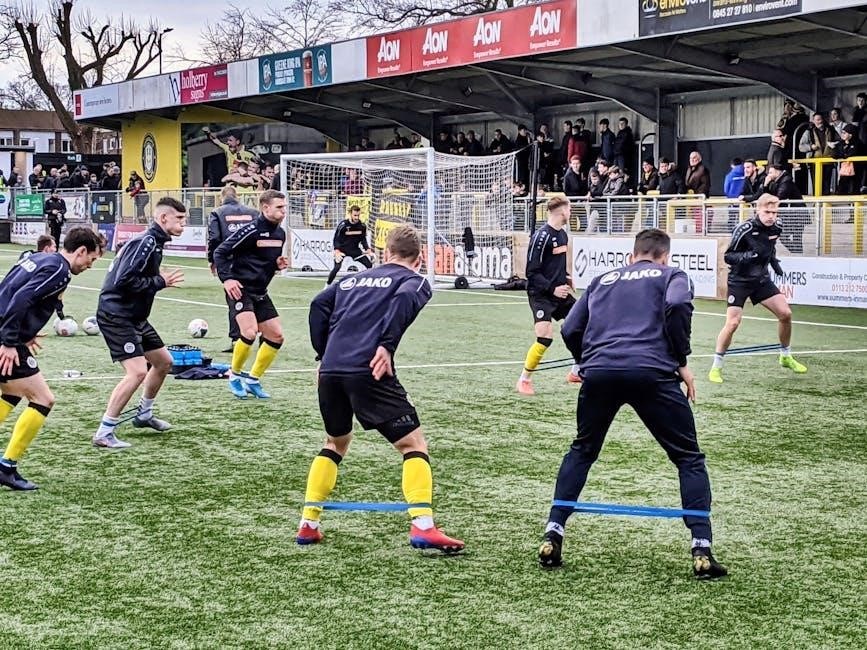DNA fingerprinting identifies individuals through unique DNA patterns. Used in forensics, it analyzes genetic material for criminal investigations and paternity testing, ensuring accuracy and reliability.
Definition and Purpose
DNA fingerprinting, or DNA profiling, is a technique used to identify individuals based on unique patterns in their DNA. It involves analyzing specific genetic markers to create a distinctive profile. The purpose is to distinguish one individual from another, making it invaluable in forensic investigations, paternity testing, and identifying human remains. By focusing on variable regions of DNA, such as short tandem repeats (STRs), scientists can generate a unique “fingerprint” for each person. This method is highly accurate and reliable, as no two individuals (except identical twins) share the same DNA profile. Its primary goal is to provide conclusive evidence in legal and personal identity cases.
Historical Background
DNA fingerprinting was first developed in 1984 by British scientist Alec Jeffreys. It emerged from his research on genetic variation and its application in identifying individuals. Jeffreys discovered that specific DNA sequences, known as restriction fragment length polymorphisms (RFLPs), could uniquely identify individuals. The technique was initially used in paternity testing and later applied to forensic investigations. The first criminal case using DNA fingerprinting occurred in 1986, solving a murder in the UK. Since then, advancements like polymerase chain reaction (PCR) and short tandem repeat (STR) analysis have improved its accuracy and efficiency, making it a cornerstone of modern forensic science. This breakthrough revolutionized identity testing and criminal investigations worldwide.
The Process of Creating DNA Fingerprints
The process involves extracting DNA, cutting it with restriction enzymes, and separating fragments using gel electrophoresis. Unique patterns are visualized, creating a DNA fingerprint for identification.
DNA Extraction
DNA extraction is the initial step in creating DNA fingerprints, involving the isolation of genetic material from cells. Biological samples like blood or tissue are treated with enzymes to break down proteins and release DNA. The DNA is then separated from other cellular components using techniques such as phenol-chloroform extraction, which isolates DNA by exploiting its solubility properties. After separation, the DNA is precipitated, often using ethanol, and collected for further analysis. This purified DNA is then ready for the next steps in the fingerprinting process, ensuring a clear and accurate representation of the genetic material for identification purposes.
Cutting DNA with Restriction Enzymes
After extracting DNA, restriction enzymes are used to cut the DNA at specific recognition sites, creating fragments of varying lengths. These enzymes recognize unique nucleotide sequences and cleave the DNA at precise locations, ensuring consistent fragment sizes for each individual. The resulting fragments are unique to the DNA donor, forming the basis of the DNA fingerprint. This step is critical for generating the distinct patterns used in identification. The fragments are then prepared for further analysis, such as gel electrophoresis, to separate and visualize the DNA fragments, enabling comparison between samples. This process ensures that each DNA sample produces a unique and identifiable pattern.
Southern Blotting Technique
The Southern blotting technique involves transferring DNA fragments from an agarose gel to a membrane, allowing for further analysis. After gel electrophoresis, the DNA fragments are denatured and transferred to a nylon or nitrocellulose membrane. This process ensures the DNA fragments are immobilized in a pattern corresponding to their separation on the gel. The membrane is then treated with labeled DNA probes that bind to specific sequences, enabling the detection of particular DNA fragments. This method is crucial for identifying and comparing DNA samples, as it provides a permanent record of the DNA fragments for further study and analysis in DNA fingerprinting.
Gel Electrophoresis
Gel electrophoresis separates DNA fragments by size using an electric field. Smaller fragments migrate faster, creating distinct bands. This technique is crucial for DNA fingerprinting and analysis.
Preparing the Gel
Preparing the gel involves dissolving agarose in a buffer solution, such as TAE or TBE, and cooling it to form a solid matrix. The solution is poured into a cast, allowed to set, and a comb is removed to create wells for DNA samples. Ethidium bromide is added to stain DNA fragments for UV visualization. The gel is placed in an electrophoresis chamber, covered with buffer, and connected to a power source. This step ensures proper separation of DNA fragments based on size, creating a clear fingerprint pattern for analysis. Safety precautions, like handling hot solutions and avoiding skin contact with ethidium bromide, are essential.
Loading DNA Samples
Loading DNA samples onto the gel is a precise step in DNA fingerprinting. Each sample, mixed with a loading buffer, is carefully pipetted into separate wells in the gel. The buffer ensures even migration of DNA fragments. A DNA ladder, with fragments of known sizes, is loaded alongside to serve as a reference. The pipette must be handled carefully to avoid cross-contamination between samples. Once loaded, the samples are ready for electrophoresis. This step is critical for ensuring clear separation of DNA fragments, which is essential for accurate fingerprinting results. Proper loading techniques prevent smearing and ensure distinct band patterns for comparison.
Running the Gel
Once the DNA samples are loaded, the gel is placed in an electric field, causing the DNA fragments to migrate through the gel matrix. Smaller fragments move faster, traveling farther, while larger fragments move slower, creating distinct band patterns. The DNA ladder, with fragments of known sizes, serves as a reference for comparing sample fragment lengths. The electric current is applied at a consistent voltage to ensure even migration. As the fragments separate, they form visible bands, which will later be analyzed. This step is crucial for achieving clear separation and accurate DNA fingerprinting results. Properly running the gel ensures distinct patterns for comparison.
Analyzing Fragment Sizes
After the gel is run, the DNA fragments are visualized, and their sizes are determined by comparing them to the DNA ladder; The ladder contains fragments of known lengths, allowing precise measurement. By aligning the sample bands with the ladder, the base pair lengths of each fragment are identified. This step ensures accurate sizing, which is critical for creating a unique DNA profile. The distinct patterns of fragment sizes are then used to compare DNA samples, enabling identification or exclusion of individuals. This analysis is a cornerstone of DNA fingerprinting, providing the data needed for precise matching in forensic and paternity cases.
Visualization and Interpretation
DNA fragments are visualized using stains or probes, creating a unique pattern. These patterns are compared to identify matches, enabling accurate identification of individuals or samples.
Using Probes for Detection
Probes are labeled with radioactive or fluorescent markers to detect specific DNA sequences. They bind to complementary regions, identifying unique patterns. This method enhances accuracy in matching DNA samples.
Staining and Imaging
After gel electrophoresis, DNA fragments are visualized using stains like ethidium bromide, which bind to DNA and fluoresce under UV light. This step highlights the unique band patterns, creating a visible DNA fingerprint. Imaging is done using specialized cameras or documentation systems to capture the fluorescent bands accurately. The resulting image is used for comparison and analysis, ensuring precise identification of DNA samples. This process is critical for forensic investigations, paternity testing, and identifying human remains, as it provides a permanent record of the DNA profile for further examination and legal purposes.
Comparing DNA Profiles
DNA profiles are compared to match suspects with crime scene evidence. Unique fragment patterns determine identification, ensuring accurate conclusions in criminal investigations and paternity cases.
Matching Suspects to Crime Scene DNA
DNA fragments from suspects and crime scenes are compared to identify matches. Gel electrophoresis separates DNA by size, creating unique patterns. By analyzing these patterns, investigators determine if a suspect’s DNA matches the evidence. This process involves extracting DNA, cutting it with restriction enzymes, and using Southern blotting to transfer fragments to a membrane. The fragments are then visualized, allowing for direct comparison. If the band patterns align, the suspect is linked to the crime scene. This method ensures accuracy in forensic investigations, providing critical evidence for legal proceedings. The technique relies on the uniqueness of DNA sequences, making it a reliable tool for identification.
Determining the Likely Suspect
After analyzing DNA fragments from suspects and the crime scene, investigators compare the patterns to identify matches. DNA fragments are separated by size using gel electrophoresis, creating unique band patterns. If a suspect’s DNA bands align with those from the crime scene, they are considered a match. This comparison relies on the uniqueness of DNA sequences, ensuring accuracy. The process involves extracting DNA, cutting it with restriction enzymes, and visualizing fragments. By matching these patterns, investigators can determine the likely suspect with high confidence. This method is critical in forensic investigations, providing reliable evidence for legal proceedings and helping solve crimes effectively.
Applications of DNA Fingerprinting
DNA fingerprinting is a powerful tool for identifying individuals. Its primary applications include forensic investigations, paternity testing, and identifying human remains, ensuring accuracy and justice.
Forensic Investigations
DNA fingerprinting is a cornerstone in forensic science, enabling investigators to analyze biological evidence from crime scenes. By extracting DNA from samples like blood, saliva, or skin cells, forensic experts can identify individuals with high precision. The process involves cutting DNA with restriction enzymes, separating fragments via gel electrophoresis, and transferring them to a membrane using Southern blotting. Probes detect specific sequences, creating a unique DNA profile. These profiles are compared to suspects’ DNA, aiding in criminal investigations and solving crimes. DNA fingerprinting’s accuracy has revolutionized law enforcement, providing critical evidence to link suspects to crime scenes or exonerate the innocent.
Paternity Testing
DNA fingerprinting is widely used in paternity testing to determine whether a man is the biological father of a child. By comparing DNA fragments from the child and the alleged father, experts can identify matching patterns that confirm genetic relatedness. This process involves extracting DNA from blood or tissue samples, cutting it with restriction enzymes, and separating the fragments using gel electrophoresis. The unique DNA profiles are then analyzed for hereditary traits. Paternity testing provides accurate results, resolving disputes and confirming lineage. Its reliability has made it a crucial tool in legal and personal matters, ensuring clarity in familial relationships.
Identification of Human Remains
DNA fingerprinting plays a vital role in identifying human remains, especially in cases where traditional methods like fingerprinting or dental records are unusable. By extracting DNA from bone or tissue samples, forensic experts can compare it to reference samples from family members or personal items. This process helps confirm identities, even in degraded conditions. DNA analysis is crucial in missing person cases and mass disasters, providing closure for families; The unique genetic patterns ensure accuracy, making it a reliable tool for resolving uncertainties surrounding unidentified remains. This application underscores the significance of DNA fingerprinting in forensic science and humanitarian efforts.
Ethical Considerations
DNA fingerprinting raises privacy concerns, as genetic data can reveal sensitive information. Legal implications include potential misuse of DNA profiles, highlighting the need for strict regulations.
Privacy Concerns
DNA fingerprinting raises significant privacy concerns, as it involves analyzing highly personal genetic information. The potential for misuse of DNA data, such as unauthorized access or discrimination, is a major ethical issue. Individuals may fear that their genetic material could be used beyond its intended purpose, leading to breaches of confidentiality. Additionally, the storage of DNA profiles in databases increases the risk of identity theft or exploitation. Strict regulations are essential to protect individuals’ genetic privacy and ensure that DNA samples are used solely for authorized purposes. Balancing the benefits of DNA fingerprinting with privacy rights remains a critical challenge.
Legal Implications
The legal implications of DNA fingerprinting are profound, as it often serves as conclusive evidence in court cases. Laws regulate the collection, storage, and use of DNA samples to prevent misuse. Challenges arise regarding the admissibility of DNA evidence, with debates over contamination risks and lab errors. Courts must ensure DNA evidence is handled properly to maintain its integrity. International laws vary, but most countries require warrants for DNA sampling. The legal system balances the power of DNA evidence with individual rights, ensuring justice while protecting privacy. Proper legal frameworks are essential to uphold the integrity of DNA fingerprinting in criminal and civil cases.
Future of DNA Fingerprinting
Advances in technology are enhancing DNA fingerprinting’s accuracy and speed. Next-generation sequencing and automated systems promise faster, more reliable results, revolutionizing forensic and medical applications globally.
Advances in Technology
Recent advancements in DNA fingerprinting include next-generation sequencing, which offers faster and more accurate analysis. Automated systems streamline the process, reducing human error and increasing efficiency. Portable DNA analyzers enable on-site testing, enhancing forensic investigations. These innovations improve the speed and reliability of DNA profiling, making it more accessible for criminal investigations, paternity testing, and identifying human remains. Additionally, advancements in gel electrophoresis and Southern blotting techniques have refined fragment separation and detection, ensuring clearer results. These technological improvements are transforming DNA fingerprinting into a more precise and versatile tool for solving crimes and answering genetic questions.
Potential for Improved Accuracy
Advancements in DNA fingerprinting techniques are enhancing accuracy by reducing contamination risks and improving fragment analysis. Gel electrophoresis and Southern blotting now incorporate high-resolution imaging, enabling clearer differentiation of DNA fragments. The use of probes with increased specificity ensures precise detection of unique sequences, minimizing false matches. Additionally, automated systems and advanced software reduce human error in interpreting DNA profiles. These improvements are critical for forensic investigations, paternity testing, and identifying human remains, ensuring reliable and conclusive results. As technology evolves, DNA fingerprinting becomes more precise, strengthening its role in solving crimes and resolving genetic questions with unparalleled accuracy.





























